Abstract
Alternanthera philoxeroides (Mart.) Griseb., commonly known as “Alligator weed” in English, and “Malancha” in Bengali, is a leafy vegetable from the family Amaranthaceae A. L. de Jussieu. This species is native to China, particularly to the provinces around the Yangtze River, other Far East and South-East Asian countries, and countries from other continents (e.g., South America). This plant also grows in certain areas in Australia, New Zealand, and the USA. While in Bangladesh the leaves of this plant are consumed as a vegetable, in China, this plant has been used widely as a traditional remedy for the treatment of various viral diseases (e.g., measles, influenza, and haemorrhagic fever). Flavonoids and saponins are the two largest groups of phytochemicals produced by this plant, and the antiviral property of this plant and its compounds has been studied extensively. This review article reviews all published literature on this plant and critically appraises its phytochemical profile linking to biomolecular interactions and therapeutic potential, particularly, against viral diseases.
1. Introduction
Alternanthera philoxeroides (Mart.) Griseb., commonly known as “Alligator weed” in English, “Malancha shak or Malancha” in Bengali, and “Shergitti” in Santal languages, is a leafy vegetable from the family Amaranthaceae A. L. de Jussieu [,,]. This perennial polymorphic herb is native to China, particularly to the provinces around the Yangtze River, Far East, and South-East Asian countries such Bangladesh, India, Myanmar, and Thailand [,,], and countries from other continents (e.g., Argentina, Brazil, and Paraguay [,] (Figure 1). This species also grows in certain areas in Australia, New Zealand, and the USA, where it is considered as an obnoxious invasive weed. In fact, it is one of the worst hazardous weeds that can rapidly invade both terrestrial and aquatic habitats.
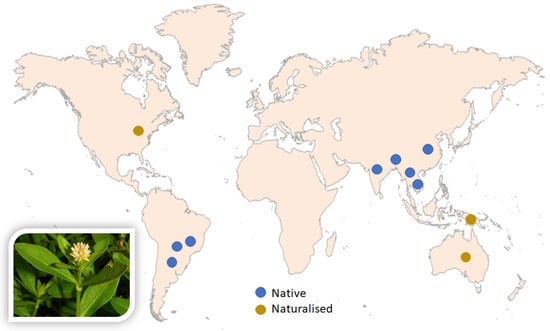
Figure 1.
Distribution map of Alternanthera philoxeroides.
While in Bangladesh the leaves of this plant are consumed as a vegetable, in China, this plant has been used extensively as a traditional remedy for various viral diseases (e.g., measles, influenza, and haemorrhagic fever) [,,,,,,]. This plant has traditionally been used in India as a remedy for anaemia, for the treatment of diarrhoea and dysentery in Bangladesh, and to treat certain blood conditions, fever, post-natal depression, wounds and to stimulate milk secretion in Thailand [,].
Despite being known as a hazardous invasive weed, because of its traditional phytotherapeutic uses, this plant has been widely investigated to furnish the presence of several biologically active secondary metabolites, and to reveal various medicinal values and therapeutic potential, particularly, against viral infections. However, no review article is available to date that appraises the findings of those investigations. Therefore, this review article critically appraises the phytochemical profile linking to biomolecular interactions and the therapeutic potential of A. philoxeroides and its purified compounds based on the published literature available to date and also explores the true potential of this plant as an antiviral therapeutic option.
2. Phytochemical Profile and Biomolecular Interactions
Several phytochemical studies have been performed on this plant [,,,,,,,,,,,,,,]. While some of these are merely preliminary qualitative and quantitative phytochemical screening without the isolation of any compounds, there are, however, several other thorough phytochemical studies that have led to the isolation and identification of various secondary metabolites from A. philoxeroides. Among at least 60 different isolated compounds, mainly from the aerial parts of this plant, flavonoids and saponins form the two major classes. The phytochemical profile as revealed by different phytochemical studies on A. philoxeroides is discussed in the following subsections under the headings of various phytochemical classes, and their interactions with various biomolecules/macromolecules are also briefly discussed.
2.1. Alkaloids
At least nine alkaloids, belonging to the classes of β-carboline, indole, phaeophytin and tyramine alkaloids (1–9) (Figure 2), have been isolated from the aerial parts of A. philoxeroides [,,,,]. The first two alkaloids, phaeophytin A (8) and phaeophytin A’ (9), were isolated from the aerial parts of this plant by Fang et al. []. Later, further alkaloids, N-trans-feruloyl-3,5-dimethoxytyramine (2), N-trans-feruloyl-3-methyldopamine (3), N-trans-feruloyl-tyramine (4), N-cis-feruloyl-tyramine (5), indole-3-carboxaldehyde (6) and indole-3-carboxylic acid (7) were reported from this plant in subsequent years [,]. Tyramine derivatives (2–5), particularly feruloyl, cinnamoyl, or coumaroyl derivatives, are widespread in the plant kingdom. N-cis-feruloyl-tyramine (5) could be an artefact formed during the isolation process as cis/trans isomerism is usually induced by light. However, natural existence of cis- and trans-isomers of various natural compounds is not uncommon. Tyramine and its derivatives have been shown to act on various biomolecular targets (e.g., monoamine oxidase (MAO), α and β1 adrenoreceptors), and thus to produce certain toxicological effects such as migraine and hypertension [,].
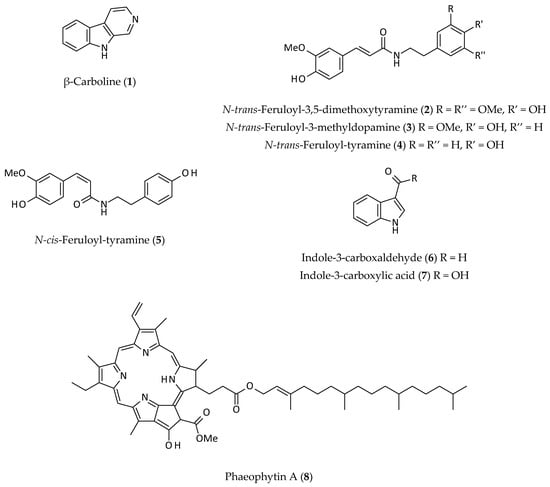

Figure 2.
Alkaloids from Alternanthera philoxeroides.
Phaeophytins or pheophytins (8 and 9) are chlorophyll molecules without a magnesium ion (Mg2+). They are essential parts of photosynthesis in plants, and act as the first electron carrier intermediate in the electron transfer pathway of the photosystem II pathway.
β-Carboline (1), reported from the aerial parts of A. philoxeroides [], has an indole unit fused with a six membered heteroaromatic ring (pyridine ring), and is the basic structure of ca. 100 alkaloids with various pharmacological properties. This group of compounds are well distributed in prokaryotes, plants, and animals. Many β-carboline analogues can intercalate into DNA and can inhibit cyclin dependent kinase (CDK), topoisomerase, and MAO []. These alkaloids also interact with benzodiazepine and 5-hydroxy-serotonin receptors, and possess anticonvulsant, antimicrobial, antitumour, antiviral, antiparasitic, anxiolytic, hypnotic, and sedative properties [].
2.2. Anthraquinones
Anthraquinones, also known as anthracenedione or 9,10-dioxoanthracene, are tricyclic aromatic compounds based on the anthracene skeleton []. Anthraquinones form a large group of pharmacologically active phytochemicals found in various plants (e.g., Aloe, Cascara, Cassia, Frangula, and Senna species). In plants, they often occur in their glycosidic forms. Three anthraquinones, 2-hydroxy-3-methylanthraquinone (10), rubiadin (11), and rubiadin-1-methyl ether (12) (Figure 3), were isolated from an ethyl acetate (EtOAc) extract of the aerial parts of A. philoxeroides by repeated column chromatography on silica gel []. None of these anthraquinones is particularly unique to this plant and can be found in other plants. 2-Hydroxy-3-methylanthraquinone (10) is found in various other Chinese medical plants (e.g., it was isolated as an anticancer principle from Hedyotis difffusa) []. Similarly, bioactive rubiadin (11) and its derivatives are also found in other plants (e.g., Morinda citrifolia and Rubia cordifolia) [,]. It can be noted that rubiadin (11), which fits the Lipinski’s rule of five for drug-likeness properties, is known to possess antibacterial, anticancer, antidiabetic, antifungal, anti-inflammatory, antimalarial, antioxidant, antiviral, hepatoprotective, and neuroprotective properties []. Natural anthraquinones usually bind to serum albumin, DNA, and glutathione (GSH) [,].

Figure 3.
Anthraquinones from Alternanthera philoxeroides.
2.3. Flavonoids
Flavonoids, having a benzo-γ-pyrone skeleton, are one of the largest groups of phenolic/polyphenolic compounds produced by A. philoxeroides [,,,,,,]. To date, at least 15 different flavonoids and their glycosides (13–27) have been reported from this plant (Figure 4).
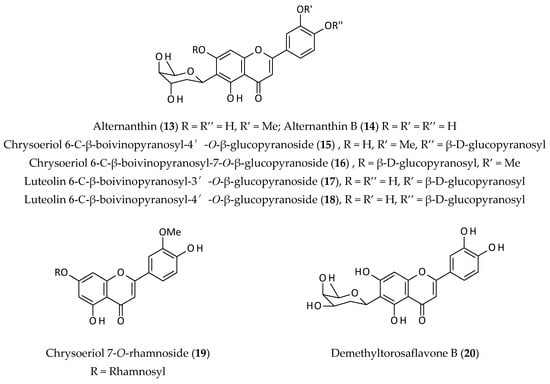
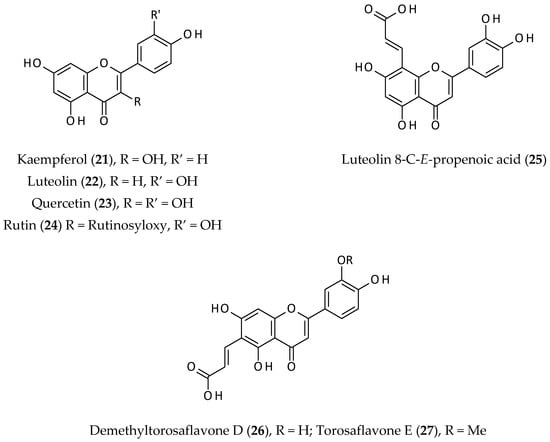
Figure 4.
Flavonoids from Alternanthera philoxeroides.
Flavonoids of this plant mainly possess chrysoeriol (19) and luteolin (22) skeletons, and alternanthins appear to be the signature flavonoids of this species [,,,,]. One of the unique features of some flavonoids of this plant is the presence of the deoxysugar boivinopyranose, which forms the C-glycosidic link to the flavonoid aglycone, as found in alternanthin (13), alternanthin B (14), and a few other chrysoeriol/luteolin glycosides (15–18).
While three propenoic acid substituted flavonoids, demethyltorosaflavone D (26), luteolin 8-C-E-propenoic acid (25), and torosaflavone (27), appear to be among the less common natural flavonoids, kaempferol (21), luteolin (22), quercetin (23), and rutin (24) are among the most abundant natural flavonoids. Alternanthin (13), the signature flavonoid of this plant, was first isolated as a novel flavonoid C-glycoside containing the rare deoxysugar boivinose from an ethanol (EtOH) (95%) extract of the stems and leaves of this plant using repeated column chromatography on silica gel and the structure was deduced with the help of UV–Vis and nuclear magnetic resonance (NMR) experiments, particularly a series of 1D nOe spectral analyses []. Khamphukdee et al. [] used solvent partitioning (with chloroform and EtOAc) of an EtOH extract of the aerial parts of this plant, followed by column chromatography on silica gel to isolate demethyltorosaflavone B (20) and torosaflavone (27) together with five other previously reported flavonoids. Among the 15 isolated flavonoids from A. philoxeroides, 11 are flavone (no substitution at C-3) and the remaining four are flavonol derivatives (oxygenation at C-3).
Flavonoids possess various pharmacological properties including anti-ageing, anticancer, anti-inflammatory, antioxidant, antimicrobial, antiparasitic, antiviral, cancer chemopreventive, cardioprotective, hepatoprotective, and immunomodulatory properties []. Several flavonoids (e.g., quercetin (23) and rutin (24)), are used in various traditional medicinal formulations and in some ‘over the counter’ medications [,,,]). In addition to medicinal values, natural flavonoids are also important as dietary components possessing health-promoting properties due to their high antioxidant capacity []. Flavonoids, depending on their structural features, can bind to several biomolecules including various enzymes. The binding affinity can be quite variable because of the structural diversity that flavonoids possess [,,,]. For example, Liu et al. [] demonstrated differential binding affinities of some known flavonoids with bovine serum albumin, and the order of affinities was hesperetin (KA = 5.59 × 105) > quercetin (4.94 × 105) > naringenin (3.04 × 105) > isoquercitrin (4.66 × 104) > icariin (3.60 × 104) > rutin (1.65 × 104) > hesperidin (2.50 × 103) > naringin (8.70 × 102). The differences in the rates of binding of these flavonoids to serum albumin were assumed to be due to differences in hydrophobicity, functional groups, steric hindrance, and the spatial arrangements of substituents.
The antiviral property of certain flavonoids is associated with their inhibiting activity against enzymes such as human immune deficiency virus (HIV-1) reverse transcriptase, proteinase, protein kinases, and DNA-polymerases [,]. For example, flavonoids baicalein, robustaflavone, and hinokiflavone inhibit HIV-1 reverse transcriptase. The interactions of flavonoids with macromolecules (e.g., lipoproteins, proteins, chromatin, DNA, and cell-signalling molecules in human diseases have been well documented) [,].
2.4. Megastigmanes
Megastigmanes are a large group of 13 carbon atoms containing nonterpenoidal natural products that are usually responsible for the characteristic aroma of certain fruits and plants []. Usually, these compounds possess a cyclohexane ring (often cyclohexanone or cyclohexen-one), a butyl side chain, and three other methyl groups. Fan et al. [] isolated blumenol A (28) from an EtOH extract of the aerial parts of A. philoxeroides, while 4,5-dihydroblumenol (29) and 6S,7E,9R-6,9-dihydroxymegastigma-4,7-dien-3-one-9-O-β-D-glucopyranoside (30) with antitumour properties were reported from an n-butanol extract of this plant [] (Figure 5).

Figure 5.
Megastigmanes from Alternanthera philoxeroides.
Natural megastigmanes are known to have various bioactivities including anticancer, antimicrobial, antioxidant, and antiviral properties [,]. For example, blumenol A (28) is weakly cytotoxic to human cancer/tumour cells [], whereas three megastigmane glucosides isolated from Lyonia ovalifolia have been shown to possess antiviral properties against the Coxsackie B3 virus []. A similar antiviral property was also observed with two megastigmane glycosides isolated from Pinus densiflora against the human influenza A virus []. Certain megastigmanes have been shown to bind to various proteins and enzymes including nucleotide-binding oligomerisation-domain protein and other macromolecules to exert pharmacological properties such as anti-inflammatory, anticancer and antiviral properties [].
2.5. Other Phenolics
Simple phenolics (31–37) and coumarins have been reported from the aerial parts of A. philoxeroides [,,,,]. However, none of the coumarins or coumarin analogues were isolated and identified from this plant, but just reported based on preliminary phytochemical screening [,]. Chlorogenic acid (31), p-coumaric acid (32), ferulic acid (33), p-hydroxybenzoic acid (34), salicylic acid (36), syringic acid (37), and vanillic acid (35) (Figure 6) are among the simple phenolics (apart from flavonoids) isolated from the aerial parts and/or leaves of this plant [,,]. All these phenolic compounds are known to possess various biological activities (e.g., analgesic, anti-inflammatory, antioxidant, anticancer, antimicrobial, and antitumour properties), and are widely distributed in the plant kingdom [].
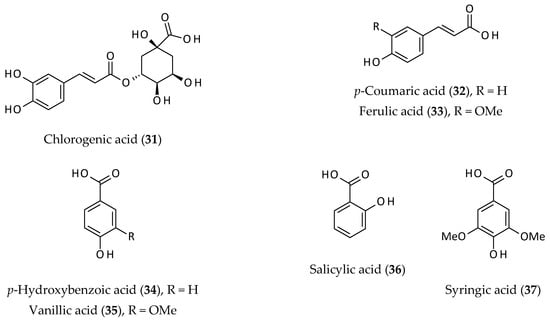
Figure 6.
Other phenolics from Alternanthera philoxeroides.
Binding ability of simple phenolic compounds (e.g., chlorogenic acid (31), ferulic acid (33) and gallic acid), to macromolecules (e.g., proteins including human serum albumin, bovine serum albumin, soy glycinin, and lysozyme is well-known) [,,]. A vast majority of phenol–protein binding takes place through covalent and non-covalent (hydrogen, hydrophobic and ionic bonds) binding, the former being an irreversible process []. However, covalent and non-covalent binding such as between chlorogenic acid (31) and proteins occurs simultaneously. The interactions between various natural phenolic acids and plasma proteins, especially serum albumin, have been studied quite extensively []. Simple phenolics such as ferulic acid (33) and rosmarinic acid could inhibit amyloid β protein aggregation, which is an important feature of Alzheimer’s disease, and thus, food rich in phenolics could potentially reduce the incidence of Alzheimer’s disease [].
2.6. Saponins
Saponins are ‘foam-forming’ natural products comprising a triterpene or steroidal aglycone unit and multiple sugar units, often in the form of di-, tri-, tetra-saccharides, and have various pharmacological and toxicological properties [,]. This is the second largest group of phytochemicals produced by A. philoxeroides, and to date, at least 13 different saponins (38–50) (Figure 7) have been isolated from the aerial parts of this plant [,,,,].
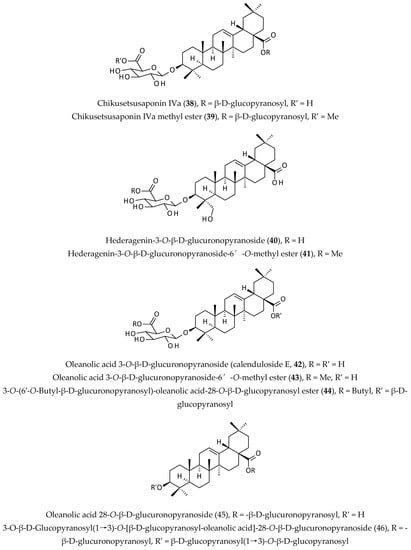
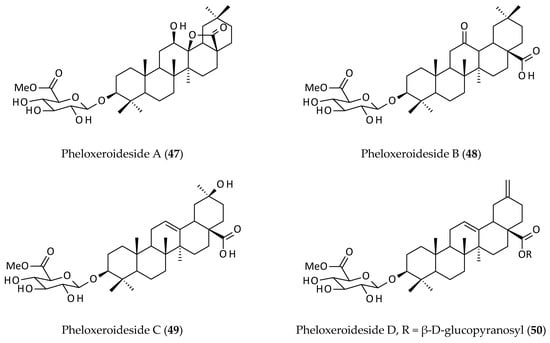
Figure 7.
Saponins from Alternanthera philoxeroides.
Dogra and Ojha [] were the first to report on the presence of saponins in this plant, which was followed by the studies undertaken by a few other groups resulting in the isolation of calenduloside E (42), chikusetsusaponin IVa (38), chikusetsusaponin IVa methyl ester (39), hederagenin 3-O-β-D-glucuronopyranoside (40), hederagenin 3-O-β-D-glucuronopyranoside-6′-O-methyl ester (41), oleanolic acid 3-O-β-D-glucuronopyranoside-6′-O-methyl ester (43), 3-O-(6′-O-butyl-β-D-glucuronopyranosyl)-oleanolic acid-28-O-β-D-glucopyranosyl ester (44), oleanolic acid 28-O-β-D-glucuronopyranoside (45), 3-O-β-D-glucopyranosyl(1→3)-O-[β-D-glucopyranosyl-oleanolic acid]-28-O-β-D-glucuronopyranoside (46), and pheloxeroidesides A-D (47–50) from various EtOH (95%) extracts of this plant [,,,,].
In most cases, a combination of solvent partitioning of the resuspended dried EtOH extract in water with n-butanol and EtOAc, repeated column chromatography on silica gel, and reversed-phase preparative HPLC afforded isolation, and an extensive 1D and 2D NMR analyses together with mass spectrometric (MS) data analyses were required to isolate and elucidate the complex structures of those saponins [,,].
Saponins are usually responsible for various pharmacological properties of medicinal plants as well as toxicities in some cases. Most notable pharmacological properties of saponins include anticancer, anticoagulant, anti-inflammatory, antimicrobial, hepatoprotective, hypocholesterolaemic, hypoglycaemic, immunomodulatory, and neuroprotective activities []. A few decades ago, possible interaction between natural saponins (quillaja saponins) and proteins (casein and soy proteins) and their influence on blood lipids, particularly low-density lipoprotein (LDL) cholesterol, was established []. Recently, it has been shown that Ginseng saponins, ginsenosides, bind to plasma lipid membranes to exert their pharmacological actions through the modulation of essential membrane proteins and the reorganisation of lipid bilayers []. As ginsenosides suppress cell proliferation, induce apoptosis, and inhibit efflux pumps, these saponins could be considered as candidates for anticancer and antimicrobial drug development [].
2.7. Sterols
Four well-known plant sterols, 3β-hydroxystigmast-5-en-7-one (51), β-sitosterol (52), α-spinasterol (53), and stigmasta-5, 22-dien-3β-ol (54), were isolated from the aerial parts of A. philoxeroides [,]) (Figure 8). These sterols are widely distributed in the plant kingdom but possess various biological properties and have health-protecting values [,,,]. One of the most prominent health effects of plant sterols is their ability to lower cholesterol level; long-term intake of certain plant sterols can lower serum cholesterol level to the extent expected to reduce clinical manifestation of coronary heart disease by over 20% without any detectable side effects []. Plant sterols interfere with sterol regulatory element-binding protein 2 and liver X receptor regulatory pathways resulting in a reduction in serum LDL cholesterol level and can be used as a therapeutic option for the management of blood cholesterol and atherosclerotic risks [].
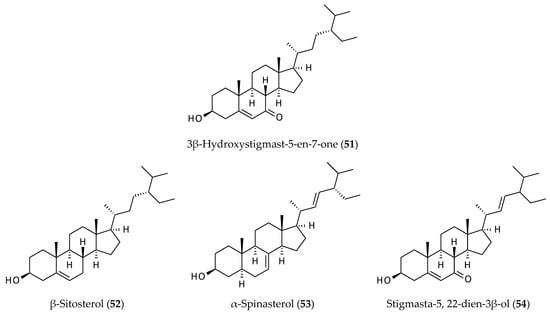
Figure 8.
Steroids from Alternanthera philoxeroides.
2.8. Terpenoids
Five different terpenoids (55–59) have been reported from A. philoxeroides to date [,,]. Among them, four are triterpenes, cycloeucalenol (55), 24-methylenecycloartanol (56), oleanoic acid or oleanolic acid (57), and ursolic acid (59) and one is a diterpene, phytol (58) (Figure 9). All of these triterpenes (55–57, 59) are well-known for having various biological activities including anticancer, antimicrobial, antiproliferative, and antitumour properties [,,,].
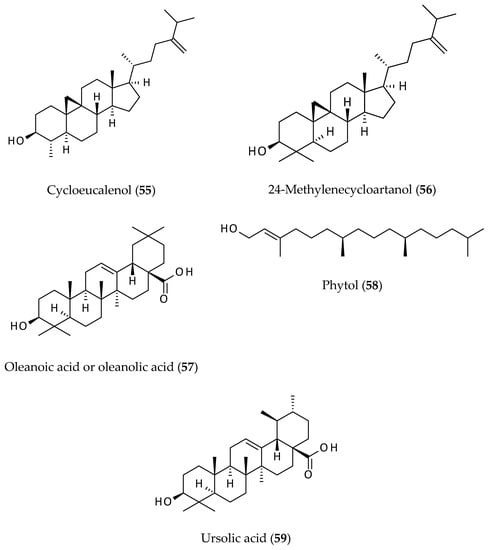
Figure 9.
Terpenoids from Alternanthera philoxeroides.
Triterpenes form a large class of natural products, ca. 20,000 discovered to date, with significant differences in structural features and functional groups, and their binding to biomolecules varies considerably. One of the major bioactivities of certain triterpenes is their antiviral property, which are mediated through their interactions with various macromolecules. For example, triterpenes have been shown to manipulate several virus–host fusions by wrapping the heptad repeat-2 (HR2) domain, which are generally found in viral envelops [], and to inhibit the entry of several viruses (e.g., Ebola, Marbug, human immunodeficiency virus (HIV), and influenza A). Natural triterpenes, particularly cycloartane and oleane classes, were shown to exert their anti-inflammatory, chemopreventive and chemotherapeutic actions through their interactions with various relevant therapeutic macromolecular targets (e.g., cyclooxygenases (COX-1 and 2), lipoxygenase (LOX-5), myeloperoxidase (MPO), phospholipase A2 (PLA2), and inducible nitric oxide synthase (iNOS)) [].
2.9. Miscellaneous
In addition to the compounds discussed in the above subsections, there were two other compounds reported from the aerial parts of A. philoxeroides, and these are vitamin C (60) [] and azelaic acid (61) [] (Figure 10). Vitamin C (60) was not isolated, but its presence in the extract was detected and quantified by a standard chemical assay for ascorbic acid (vitamin C). It was found that the tested sample of A. philoxeroides contained ca. 34.52 mg/100 g of vitamin C. Vitamin C is an essential vitamin, a well-known antioxidant, and possesses various other beneficial effects, whereas azelaic acid (61) is known to have dermatological applications and other pharmacological properties [,,]. Shawon et al. [] demonstrated molecular recognition (binding affinity and non-bonding interactions) of azelaic acid (61) with DNA polymerase I in silico.

Figure 10.
Ascorbic acid and azelaic acid from Alternanthera philoxeroides.
4. Toxicological Aspects
While no thorough and systematic toxicological studies have been performed with the extracts of A. philoxeroides, a few preliminary studies, for example, an assessment of toxicity towards host cells [], revealed that the extracts are reasonably nontoxic. Furthermore, as this plant is widely consumed as a leafy vegetable in some countries without the experience of any noticeable toxicity at the amounts consumed, it could be assumed that this plant might not cause any harm to humans. However, looking at the phytochemical profile, one might wonder whether the presence of toxic compounds such as tyramine and β-carboline alkaloids as well as saponins might contribute to certain level of toxicities of the extracts. On a positive note, these compounds are not present in high amounts in the extracts, suggesting that the amounts could be well below the threshold for showing any toxicity in humans.
5. Conclusions
Although somewhat neglected as an invasive weed, A. philoxeroides has been used as a leafy vegetable and as a traditional medicine for phytotherapeutic interventions in various human ailments, particularly, different viral infections (e.g., influenza and measles). Previous phytochemical studies have furnished the presence of at least 60 different secondary metabolites, where flavonoids and saponins are the two largest phytochemical groups. Various pharmacological and biological activity screenings have unveiled the therapeutic potential of crude extracts as well as isolated compounds from this plant against various diseases, especially, against human pathogenic viruses such as HIV, HBV, and so on. Some of the findings of the reported bioactivities studies certainly provide strong scientific rationale for traditional medicinal uses of this plant, particularly, its uses against viral infections. However, more preclinical and toxicity studies as well as well-designed clinical trials are needed before any confirmed therapeutic recommendations can be made on the crude extracts or purified bioactive compounds from this plant.
Author Contributions
L.N., S.N. and S.D.S. contributed equally to the collation of relevant information from an extensive literature search. Additionally, L.N. and S.D.S. prepared, edited, and submitted the manuscript as corresponding authors. All authors have read and agreed to the published version of the manuscript.
Funding
Lutfun Nahar gratefully acknowledges the financial support of the European Regional Development Fund—Project ENOCH (No. CZ.02.1.01/0.0/0.0/16_019/0000868).
Data Availability Statement
All relevant data have been presented as an integral part of this manuscript.
Acknowledgments
Lutfun Nahar gratefully acknowledges the financial support of the European Regional Development Fund—Project ENOCH (No. CZ.02.1.01/0.0/0.0/16_019/0000868).
Conflicts of Interest
The authors declare no conflict of interest.
References
- Khatun, M.; Hassan, M.A.; Islam, S.N.; Rahman, M.O. Taxonomy of the leafy vegetables in Bangladesh. Bangladesh J. Plant Taxon. 2013, 20, 95–123. [Google Scholar] [CrossRef] [Green Version]
- Sunmathi, D.; Sivakumar, R. In Vitro cytotoxicity of ethanolic leaf extract of Alternanthera sessilis (L.) R. Br. Ex. DC and Alternanthera philoxeroides (Mart.) Griseb. Against human osteosarcoma cell line MG-63. Eur. J. Biomed. Pharm. Sci. 2016, 3, 416–420. [Google Scholar]
- Akbar, M.; Amin, A.; Khalil, T.; Iqbal, M.S.; Nazir, A.; Taswar, A. Antibacterial activity of Alternanthera philoxeroides (Mart.) Griseb. against bacterial phytopathogens: Erwinia carotovora, Ralstonia solanacearum and Xanthomonas axonopodis. Allelopath. J. 2021, 53, 83–92. [Google Scholar] [CrossRef]
- Zhou, B.-N.; Gabor, B.; Cordell, G.A. Alternanthin, a glycosylated flavonoid from Alternanthera philoxeroides. Phytochemistry 1988, 27, 3633–3636. [Google Scholar] [CrossRef]
- Fang, J.-B.; Jia, W.; Gao, W.-Y.; Yao, Z.; Teng, J.; Zhao, A.-H.; Duan, H.-Q. Antitumor constituents from Alternanthera Philoxeroides. J. Asian Nat. Prod. Res. 2007, 9, 511–516. [Google Scholar] [CrossRef]
- Bhattacharjee, A.; Ghosh, T.; Sil, R.; Datta, A. Isolation and characterisation of methanol-soluble fraction of Alternanthera philoxeroides (Mart.) evaluation of their antioxidant, α-glucosidase inhibitory and antimicrobial activity in vitro systems. Nat. Prod. Res. 2014, 28, 2199–2202. [Google Scholar] [CrossRef]
- Kleinowski, A.M.; Ribeiro, G.A.; Milech, C.; Braga, E.J.B. Potential allelopathic and antibacterial activity from Alternanthera Philoxeroides. Hoehnea 2016, 43, 533–540. [Google Scholar] [CrossRef] [Green Version]
- Fang, J.B.; Yao, Z.; Chen, J.C.; Liu, Y.W.; Takaishi, Y.; Hongquan, Y.D. Cytotoxic triterpene saponins from Alternanthera philoxeroides. J. Asian Nat. Prod. Res. 2009, 11, 261–266. [Google Scholar] [CrossRef]
- Fang, J.B.; Liu, J.C.; Hongquan, Y.D. Constituents from Alternanthera philoxeroides and their antitumour activity. Zhongguo Zhong Yao Za Zhi China J. Chin. Mater. Med. 2009, 34, 2473–2476. [Google Scholar]
- Li, B.; Guo, Q.-L.; Tian, Y.; Liu, S.-J.; Wang, Q.; Li, C.; Dong, J.-X. New anti-HBV C-boivinopyranosyl flavones from Alternanthera philoxeroides. Molecules 2016, 21, 336. [Google Scholar] [CrossRef] [Green Version]
- Khamphukdee, C.; Monthakantirat, O.; Chulikhit, Y.; Buttachon, S.; Lee, M.; Silva, A.M.S.; Sekeroglu, N.; Kijioa, A. Chemical constituents and antidepressant-like effects in ovariectomized mice of the ethanol extract of Alternanthera philoxeroides. Molecules 2018, 23, 2202. [Google Scholar] [CrossRef] [PubMed] [Green Version]
- Fan, W.-Q.; Xiong, M.-X.; Ma, Z.; Li, Q.-Y.; Liu, Y.-W. Chemical constituents of Alternanthera philoxeroides. Chin. J. Nat. Med. 2008, 6, 112–115. [Google Scholar] [CrossRef]
- Rattanathongkom, A.; Sripanidkulchai, B.O.; Kanchanapoom, T. Immunomodulatory activity of chikusetsusaponin Iva from Alternanthera philoxeroides. Isan J. Pharm. Sci. 2008, 4, 113–120. [Google Scholar]
- Fang, J.B.; Duan, H.Q.; Zhang, Y.W.; Yoshihisa, T. Chemical constituents from herb of Alternanthera philoxeroides. Zhongguo Zhong Yao Za Zhi China J. Chin. Mater. Med. 2006, 31, 1072–1075. [Google Scholar]
- Tukun, A.B.; Shaheen, N.; Banu, C.P.; Mohiduzzaman, M.; Islam, S.; Begum, M. Antioxidant capacity and total phenolic contents in hydrophilic extracts of selected Bangladeshi medicinal plants. Asian Pac. J. Trop. Med. 2014, 7, S568–S573. [Google Scholar] [CrossRef] [Green Version]
- Zhang, X.K.; Li, P.; Guo, S.H.; Wang, S.Q.; Liu, D.S. Quantitation of β-carboline and quercetin in alligator weed (Alternanthera philoxeroides (Mart.) Griseb.) by LC-MS/MS and evaluation of cardioprotective effects of the methanol extracts. Drug Discov. Ther. 2018, 12, 341–346. [Google Scholar] [CrossRef] [Green Version]
- Pulipati, S.; Babu, P.S. In-vitro antibacterial potential of Alternanthera philoxeroides (Mart.) Griseb. against multi-drug resistant uropathogens. Int. J. Pharm. Sci. Res. 2020, 11, 3834–3840. [Google Scholar]
- Raj, A.; Sikdar, B.; Roy, A.; Mukhopadhyay, A.K.; Roy, S. Antioxidant and Antibacterial Activities of Phytochemicals in Methanolic Extracts of Five Underutilized Leafy Vegetables. Res. J. Biotechnol. 2021, 16, 1–10. [Google Scholar] [CrossRef]
- Andersen, G.; Marchinek, P.; Sulzinger, N.; Schieberle, P.; Krautwurst, D. Food sources and biomolecular targets of tyramine. Nutr. Rev. 2019, 77, 107–115. [Google Scholar] [CrossRef]
- Gillman, P.K. Monoamine oxidase inhibitors: A review concerning dietary tyramine and drug interactions. Psychotr. Comment. 2016, 1, 1–90. [Google Scholar]
- Cao, R.; Peng, W.; Wang, Z.; Xu, A. β-Carboline alkaloids: Biochemical and pharmacological functions. Curr. Med. Chem. 2007, 14, 479–500. [Google Scholar] [CrossRef] [PubMed]
- Patel, K.; Gadewar, M.; Tripathi, R.; Prasad, S.K.; Patel, D.K. A review on medicinal importance, pharmacological activity and bioanalytical aspects of β-carboline alkaloid “harmine”. Asian J. Trop. Biomed. 2012, 2, 660–664. [Google Scholar] [CrossRef] [Green Version]
- Nahar, L.; Sarker, S.D. Chemistry for Pharmacy Students—General, Organic and Natural Product Chemistry, 2nd ed.; Wiley & Sons: Chichester, UK, 2019. [Google Scholar]
- Sun, C.; Yang, J.; Cheng, H.-B.; Shen, W.-X.; Jiang, Z.-Q.; Wu, M.-J.; Li, L.; Li, W.-T.; Chen, T.-T.; Rao, X.-W.; et al. 2-Hydroxy-3-methylanthraquinone inhibits lung carcinoma cells through modulation of IL-6-induced JAK2/STAT3 pathway. Phytomedicine 2019, 61, 152848. [Google Scholar] [CrossRef] [PubMed]
- Bussmann, R.W.; Henning, L.; Giannis, A.; Ortwein, J.; Kutchan, T.M.; Feng, X. Anthraquinone content in Noni (Morinda citrifolia L.). Evid.-Based Complement. Altern. Med. 2013, 208378. [Google Scholar] [CrossRef] [Green Version]
- Watroly, M.N.; Sekar, M.; Fuloria, S.; Gan, S.H.; Jeyabalan, S.; Wu, Y.S.; Subramaniyan, V.; Sathasivam, K.V.; Ravi, S.; Lum, P.T.; et al. Chemistry, biosynthesis, physicochemical and biological properties of rubiadin: A promising natural anthraquinone for new drug discovery and development. Drug Des. Dev. Ther. 2021, 15, 4527–4549. [Google Scholar] [CrossRef]
- Panigrahi, G.K.; Verma, N.; Singh, N.; Asthana, S.; Gupta, S.K.; Tripathi, A.; Das, M. Interaction of anthraquinones of Cassia occidentalis with DNA and glutathione. Toxicol. Rep. 2018, 5, 164–172. [Google Scholar] [CrossRef]
- Beckford, S.J.; Dixon, D.W. Molecular dynamics of anthraquinone DNA intercalators with polyethylene glycol side chains. J. Biomol. Struct. Dyn. 2012, 19, 1065–1080. [Google Scholar] [CrossRef] [PubMed]
- Khamphukdee, C.; Chulikhit, Y.; Daodee, S.; Monthakantirat, O. Potential of Alternanthera philoxeroides on improvement of anxiety-like behavior induced by ovariectomized mice model. Indian J. Pharm. Educ. Res. 2017, 51, S494–S497. [Google Scholar] [CrossRef] [Green Version]
- Kumar, S.; Pandey, A.K. Chemistry and biological activities of flavonoids: An overview. Sci. World J. 2013, 162750. [Google Scholar] [CrossRef] [PubMed] [Green Version]
- Batiha, G.E.; Beshbishy, A.M.; Ikram, M.; Mulla, Z.S.; El-Hack, M.E.A.; Taha, A.E.; Algammal, A.M.; Elewa, Y.H.A. The pharmacological activity, biochemical properties and pharmacokinetics of the major natural polyphenolic flavonoid: Quercetin. Foods 2020, 9, 374. [Google Scholar] [CrossRef] [PubMed] [Green Version]
- Juca, M.M.; Filho, F.M.S.C.; de Almeida, J.C.; da Silva Mesquita, D.; de Moraes Barriga, J.R.; Dias, K.C.F.; Barbosa, T.M.; Vasconcelos, L.C.; Leal, L.K.A.M.; Ribeiro, J.E.; et al. Flavonoids: Biological activities and therapeutic potential. Nat. Prod. Res. 2020, 34, 692–705. [Google Scholar] [CrossRef] [PubMed]
- Dufour, C.; Loonis, M.; Dangles, O. Inhibition of the peroxidation of linoleic acid by the flavonoid quercetin within their complex with human serum albumin. Free Radic. Biol. Med. 2007, 43, 241–252. [Google Scholar] [CrossRef] [PubMed]
- Sengupta, B.; Sengupta, P.K. The interaction of quercetin with human serum albumin: A fluorescence spectroscopic study. Biochem. Biophys. Res. Commun. 2002, 299, 400–403. [Google Scholar] [CrossRef]
- Liu, S.; Guo, C.; Guo, Y.; Yu, H.; Greenway, F.; Sun, M.-Z. Comparative binding affinities of flavonoid phytochemicals with bovine serum albumin. Iran. J. Pharm. Res. 2014, 13, 1019–1028. [Google Scholar] [PubMed]
- Navarro-Retamal, C.; Caballero, J. Flavonoids as CDK1 inhibitors: Insights in their binding orientations and structure activity relationships. PLoS ONE 2016, 11, e0161111. [Google Scholar] [CrossRef]
- Attrahimovich, D.; Avni, D.; Khatib, S. Flavonoids-macromolecules interactions in human diseases with focus on Alzheimers, atherosclerosis and cancer. Antioxidants 2021, 10, 423. [Google Scholar] [CrossRef]
- Gao, M.; Tang, G.-Y. Structural basis for great protein-binding potential of flavonoids: A case study of quercetin. Nat. Prod. Commun. 2017, 12, 1817–1818. [Google Scholar] [CrossRef] [Green Version]
- Liu, X.; Tian, F.; Zhang, H.-B.; Pilarinou, E.; McLaughlin, J.L. Biologically active blumenol A from the leaves of Annona glabra. Nat. Prod. Lett. 1999, 14, 77–81. [Google Scholar] [CrossRef]
- Lv, X.-J.; Li, Y.; Ma, S.-G.; Qu, J.; Liu, Y.-B.; Li, Y.-H.; Zhang, D.; Li, L.; Yu, S.-S. Bioactive megastigmane glucosides and monoterpenes from Lyonia ovalifolia. J. Asian Nat. Prod. Res. 2019, 21, 559–572. [Google Scholar] [CrossRef]
- Ha, T.K.Q.; Lee, B.W.; Nguyen, N.H.; Cho, H.M.; Venkatesan, T.; Doan, T.P.; Kim, E.; Oh, W.K. Antiviral activities of compounds isolated from Pinus densiflora (Pine Tree) against the unfluenza A virus. Biomolecules 2020, 10, 711. [Google Scholar] [CrossRef]
- Chen, Y.-C.; Chia, Y.-C.; Huang, B.-M. Phytochemicals from Polyalthia species: Potential and implication on antioxidant, anti-inflammatory, anticancer and chemopreventive activities. Molecules 2021, 26, 5369. [Google Scholar] [CrossRef] [PubMed]
- Yang, Z.Q.; Zhang, M.Y.; Liu, J.J.; Hu, Z.J.; Zhu, B.L.; Liu, Y.W.; Wang, G.Z.; Wan, N.; Wu, X.L. Extraction of effective parts of Alternanthera philoxeroides (Mart.) Griseb. And its antiviral effect. Zhongguo Zhong Yao Za Zhi China J. Chin. Mater. Med. 1989, 14, 488–490, 511–512. [Google Scholar]
- Jiang, W.-L.; Luo, X.-L.; Kuang, S.-J. Effects of Alternanthera philoxeroides Griseb. against dengue virus in vitro. Di Yi Jun Yi Da Xue Xue Bao 2005, 25, 454–456. [Google Scholar] [PubMed]
- Rawel, H.M.; Meidtner, K.; Kroll, J. Binding of selected phenolic compounds to proteins. J. Agric. Food Chem. 2005, 53, 4228–4235. [Google Scholar] [CrossRef]
- Schefer, S.; Oest, M.; Rohn, S. Interactions between phenolic acids, proteins and carbohydrates—Influence on dough and bread properties. Foods 2021, 10, 2798. [Google Scholar] [CrossRef]
- Zhang, H.; Yu, D.; Sun, J.; Liu, X.; Jiang, L.; Guo, H.; Ren, F. Interaction of plant phenols with food macronutrients: Characterisation and nutritional-physiological consequences. Nutr. Res. Rev. 2014, 27, 1–15. [Google Scholar] [CrossRef] [Green Version]
- Ono, K.; Li, L.; Takamura, Y.; Yoshiike, Y.; Zhu, L.; Han, F.; Mao, X.; Ikeda, T.; Takasaki, J.-I.; Nishijo, H.; et al. Phenolic compounds prevent amyloid b-protein oligomerisation and synaptic dysfunction by site-specific binding. J. Biol. Chem. 2012, 287, 14631–14643. [Google Scholar] [CrossRef] [Green Version]
- Rao, A.V.; Garfinkel, D.M. The bioactivity of saponins: Triterpenoid and steroidal glycosides. Drug Metab. Drug Interact. 2000, 17, 211–235. [Google Scholar] [CrossRef]
- Dogra, J.V.V.; Ojha, O.P. Saponin from Alternanthera philoxeroides (Mart.) Griseb. Comp. Physiol. Ecol. 1978, 3, 5–6. [Google Scholar]
- Rattanathongkom, A.; Lee, J.B.; Hyashi, K.; Sripanidkulchai, B.O.; Kanchanapoom, T.; Hyashi, T. Evaluation of chikusetsusaponin Iva isolated from Alternanthera philoxeroides for its potency against viral replication. Planta Med. 2009, 75, 829–835. [Google Scholar] [CrossRef]
- Guo, Q.-I.; Li, B.; Li, J.; Li, J.-J.; Xia, L.-Y.; Dong, J.-X. Triterpenoid saponins of Alternanthera philoxeroides (Mart.) Griseb. Yaoxue Xuebao Acta Pharm. Sin. 2011, 46, 428–431. [Google Scholar]
- Potter, S.M.; Jimenez-Flores, R.; Pollack, J.; Lone, T.A.; Berber-Jimenez, M.D. Protein-saponin interaction and its influence on blood lipids. J. Agric. Food Chem. 1993, 41, 1287–1291. [Google Scholar] [CrossRef]
- Verstraeten, S.L.; Lorent, J.H.; Mingeot-Leclercq, M.-P. Lipid membranes as key targets for the pharmacological actions of ginsenosides. Front. Pharmacol. 2020, 11, 576887. [Google Scholar] [CrossRef] [PubMed]
- Ilekofehinti, O.O.; Iwaloye, O.; Olawale, F.; Ariyo, E.O. Saponins in cancer treatment: Current progress and future prospects. Pathophysiology 2021, 28, 250–272. [Google Scholar] [CrossRef]
- Miettinen, T.A.; Gylling, H. Non-nutritive bioactive constituents of plants: Phytosterols. Int. J. Vitam. Nutr. Res. 2003, 73, 127–134. [Google Scholar] [CrossRef]
- De Smet, E.; Mensink, R.P.; Plat, J. Effects of plant sterols and stanols on intestinal cholesterol metabolism: Suggested mechanisms from past to present. Mol. Nutr. Food Res. 2012, 56, 1058–1072. [Google Scholar] [CrossRef]
- Ras, R.T.; van der Schouw, Y.T.; Trautwein, E.A.; Sioen, I.; Dalmeijer, G.W.; Zock, P.L.; Beulens, J.W. Intake of phytosterols from natural sources and risk of cardiovascular disease in the European perspective investigation into cancer and nutrition—The Netherland’s (epic-nl) population. Eur. J. Prev. Cardiol. 2015, 22, 1067–1075. [Google Scholar] [CrossRef]
- Salehi, B.; Quispe, C.; Sharifi-Rad, J.; Cruz-Martins, N.; Nigam, M.; Mishra, A.P.; Konovalov, D.A.; Orobinskaya, V.; Abu-Reidah, I.M.; Zam, W.; et al. Phytosterols: From preclinical evidence to potential clinical applications. Front. Pharmacol. 2020, 11, 599959. [Google Scholar] [CrossRef]
- Calpe-Berdiel, L.; Escola-Gil, J.C.; Blanco-Vaca, F. New insights into the molecular actions of plant sterols and stanols in cholesterol metabolism. Atherosclerosis 2009, 203, 18–31. [Google Scholar] [CrossRef]
- Adewusi, E.M.; Steenkamp, P.; Fouche, G.; Steenkamp, V. Isolation of cycloeucalenol from Boophone disticha and evaluation of its cytotoxicity. Nat. Prod. Commun. 2013, 8, 1213–1216. [Google Scholar] [CrossRef] [Green Version]
- Ayleso, T.B.; Matumba, M.G.; Mukwevho, E. Oleanolic acid and its derivatives: Biological activities and therapeutic potential in chronic diseases. Molecules 2017, 22, 1915. [Google Scholar] [CrossRef] [PubMed] [Green Version]
- Jesus, J.A.; Lago, J.H.G.; Laurenti, M.D.; Yamamoto, E.S.; Passero, L.F.D. Antimicrobial activity of oleanolic and ursolic acid: An update. Evid.-Based Complement. Altern. Med. 2015, 2015, 620472. [Google Scholar] [CrossRef] [PubMed]
- Mlala, S.; Oyedeji, A.O.; Gondwe, M.; Oyedeji, O.O. Ursolic acid and its derivatives as bioactive agents. Molecules 2019, 24, 2751. [Google Scholar] [CrossRef] [Green Version]
- Si, L.; Meng, K.; Tian, Z.; Sun, J.; Li, H.; Zhang, Z.; Soloveva, V.; Li, H.; Fu, G.; Xia, Q.; et al. Triterpenoids manipulate a broad range of virus-host fusion via wrapping the HR2 domain prevalent in viral envelop. Sci. Adv. 2018, 4, eaau8408. [Google Scholar] [CrossRef] [PubMed] [Green Version]
- Loza-Mejia, M.; Salazar, J.R. Sterols and triterpenoids as potential anti-inflammatories: Molecular docking studies for binding to some enzymes involved in inflammatory pathways. J. Mol. Graph. Model. 2015, 62, 18–25. [Google Scholar] [CrossRef]
- Nakhuru, K.S.; Lokho, A.; Barman, M.; Das, J.; Dwivedi, S.K. Evaluation of vitamin C of ethno-wild edible plants in Northeast India. Plant. Sci. Today 2021, 8, 473–481. [Google Scholar] [CrossRef]
- Breathnach, A.S. Pharmacological properties of azelaic acid. Clin. Drug Investig. 1995, 10, 27–33. [Google Scholar] [CrossRef]
- Kumar, A.; Rao, R.; Yadav, P. Azelaic acid: A promising agent for dermatological applications. Curr. Drug Ther. 2020, 15, 181–193. [Google Scholar] [CrossRef]
- Subroto, E.; Putri, N.G.; Rahmani, F.R.; Nuramalia, A.F.; Musthafa, D.A. Bioavailability and bioactivity of vitamin C—A review. Int. J. Pharm. Res. 2021, 13, 128–142. [Google Scholar]
- Shawon, J.; Khan, A.M.; Rahman, A.; Hoque, M.M.; Khan, M.A.K.; Sarwar, M.G.; Halim, M.A. Molecular recognition of azelaic acid and related molecules with DNA polymerase I investigated by molecular modeling calculations. Interdiscip. Sci. 2018, 10, 525–537. [Google Scholar] [CrossRef]
- Majumder, S.; Al-Rashid, M.H.; Chowdhury, S.; Gupta, B.K.; Mandal, S.C. Physicochemical and antioxidant assay of Ayurvedic formulations of Alternanthera philoxeroides. Int. Res. J. Pharm. 2016, 7, 20–23. [Google Scholar] [CrossRef]
- Rawani, A.; Pal, S.; Chandra, G. Evaluation of antimicrobial properties of four extracts against human pathogens. Asian Pac. J. Trop. Biomed. 2011, 1, S71–S75. [Google Scholar] [CrossRef]
- Maddox, C.E.; Laur, L.M.; Tian, L. Antibacterial activity of phenolic compounds against the phytopathogenic Xylella Fastidiosa. Curr. Microbiol. 2010, 60, 53–58. [Google Scholar] [CrossRef] [PubMed] [Green Version]
- Bouarab-Chibane, L.; Forquet, V.; Lanteri, P.; Clement, Y.; Leonard-Akkari, L.; Oulahal, N.; Degraeve, P.; Bordes, C. Antibacterial properties of polyphenols: Characterisation and QSAR (quantitative- structure-activity relationship) models. Front. Microbiol. 2019, 10, 829. [Google Scholar] [CrossRef] [PubMed]
- Bhattacharjee, A.; Ghosh, T.; Sil, R.; Datta, A. Green synthesis and characterisation of antioxidant-tagged gold nanoparticles (X-GNP) and studies on its potent antimicrobial activity. J. Exp. Nanosci. 2018, 13, 50–61. [Google Scholar] [CrossRef] [Green Version]
- Chang, D.; Liu, J.; Bilinski, K.; Xu, L.; Steiner, G.Z.; Seto, S.W.; Bensoussan, A. Herbal medicine for the treatment of vascular dementia: An overview of scientific evidence. Evid.-Based Complement. Altern. Med. 2016, 7293626. [Google Scholar] [CrossRef] [Green Version]
- Khamphukdee, C.; Monthakantirat, O.; Chulikhit, Y.; Boonyarat, C.; Daodee, S.; Aon-im, P.; Maneenet, J.; Chotritthirong, Y.; Luecha, P.; Sekeroglu, N.; et al. Antidementia effects of Alternanthera philoxeroides in ovariectomized mice supported by NMR-based metabolomic analysis. Molecules 2021, 26, 2789. [Google Scholar] [CrossRef]
- Mohammad, H.F.; Roodabeh, B.; Roja, R.; Faezeh, A.; Mohammad, A. A Systematic review of plant-derived natural compounds for anxiety disorders. Curr. Top. Med. Chem. 2016, 16, 1924–1942. [Google Scholar]
- Hernandez-Leon, A.; González-Trujano, M.E.; Fernández-GuAPti, A. The anxiolytic-like effect of rutin in rats involves GABAA receptors in the bAPolateral amygdala. Behav. Pharmacol. 2017, 28, 303–312. [Google Scholar] [CrossRef]
- Khatun, F.; Zaman, F.; Mossiab, T.; Mostafa, F.; Zaman, M.; Rehana, F.; Nasrin, D.; Jamal, F.; Nahar, N.; Rahmatullah, M. Evaluation of antinociceptive and antihyperglycemic activities in methanol extracts of whole plants of Alternanthera philoxeroides (Mart.) Griseb. (Amaranthaceae) in mice. Pak. J. Pharm. Sci. 2012, 25, 583–587. [Google Scholar]
- Noronha, A.B.; Gil, V.L.; Vicente, M.; Gonzalves, A.L. Occurrence of plant virus inhibitors om 5 species of Caryophylales 2. Alternanthera amoena, Alternanthera brasiliana, Alternanthera philoxeroides, Iresine herbstii and Talinum paniculatum. Fitopatologia Brasileira 1983, 8, 317–324. [Google Scholar]
- Niu, R. A study of the preventative and therapeutic effects of Alternanthera philoxeroides on influenza. Chin. J. Mod. Dev. Tradit. Med. 1988, 6, 29–30. [Google Scholar]
- Zhang, S.-M.; He, Y.-S.; Tabba, H.D.; Smith, K.M. Inhibitor against the human immunodeficiency virus in aqueous extracts of Alternanthera philoxeroides. Chin. Med. J. 1988, 101, 861–866. [Google Scholar] [PubMed]
- Qu, C.F.; Yang, Z.Q.; Xiang, J.M. Alternanthera philoxeroides (Mavt.) Griseb protection against fetal epidemic hemorrhagic fever virus infection in suckling mice. Zhongguo Zhong Yao Za Zhi China J. Chin. Mater. Med. 1993, 18, 304–305, 320. [Google Scholar]
- Peng, H.; Qu, C.; Yang, Z.; Liu, Y. Studies on antiviral effect of extract from Alternanthera philoxeroides Griseb. on epidemic hemorrhagic fever virus in vivo. Antivir. Res. 1997, 34, A90. [Google Scholar]
- Jiang, W.-L.; Yang, Z.-Q.; Chen, W.; Xiao, H.; Luo, X.-L. Effects of Alternanthera philoxeroides Griseb. against respiratory syncytial virus infection in mice. Nan Fang Yi Ke Da Xue Bao J. South. Med. Univ. 2007, 27, 62–64. [Google Scholar]
- Wang, W.; Chen, H.; Yang, Z. Antiviral effect of Alternanthera philoxeroides microemulsion on coxsackie virus group-3 in vitro. Wuhan Daxue Xuebao Yixue Ban 2005, 26, 700–703. [Google Scholar]
- Abd Kadir, S.L.; Yaakob, H.; Zulkiffi, R.M. Potential anti-dengue medicinal plants: A review. J. Nat. Med. 2013, 67, 677–689. [Google Scholar] [CrossRef] [Green Version]
- Kausar, S.; Khan, F.S.; Ishaq, M.; Rehman, M.U.; Akram, M.; Riaz, M.; Rasool, G.; Khan, A.H.; Saleem, I.; Shamim, S.; et al. A review: Mechanisms of action of antiviral drugs. Int. J. Immunopathol. Pharmacol. 2021, 35, 1–12. [Google Scholar] [CrossRef]
- Resende, F.A.; de Oliveira, A.P.S.; de Camargo, M.S.; Vilegas, W.; Varanda, E.A. Evaluation of estrogenic potential of flavonoids using a recombinant yeast strain and MCF7/BUS cell proliferation assay. PLoS ONE 2013, 8, e74881. [Google Scholar] [CrossRef]
Publisher’s Note: MDPI stays neutral with regard to jurisdictional claims in published maps and institutional affiliations. |
© 2022 by the authors. Licensee MDPI, Basel, Switzerland. This article is an open access article distributed under the terms and conditions of the Creative Commons Attribution (CC BY) license (https://creativecommons.org/licenses/by/4.0/).

